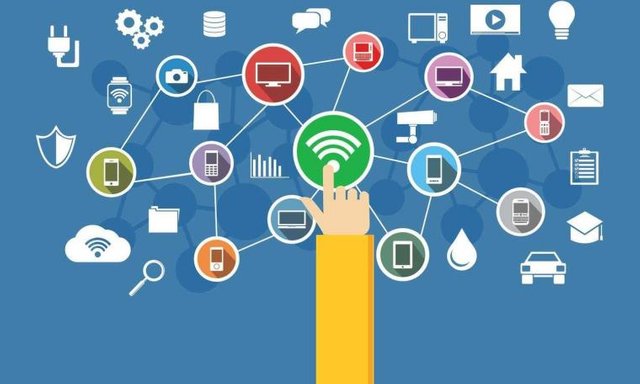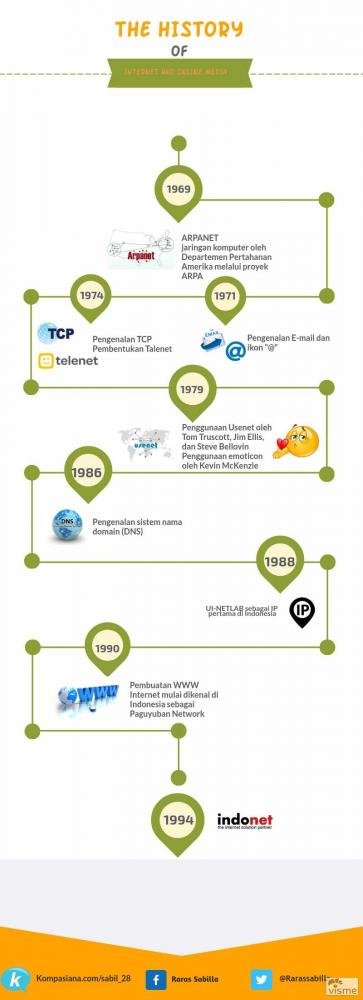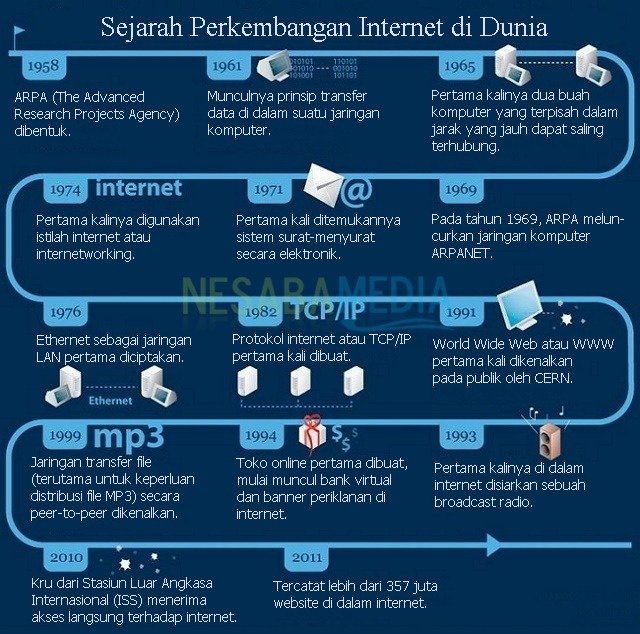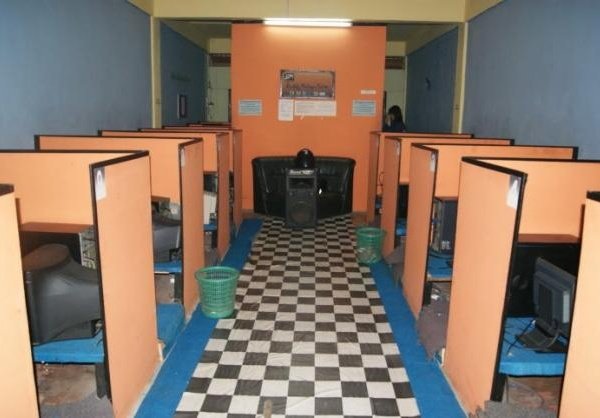Internet History and Internet Development Year by Year (Both in the World and in Indonesia)
as a loyal user of the internet it's good we understand how history originally. thank you for visiting, happy to share your knowledge. "Internet History in the World and Indonesia."
To find out, below will display internet history, starting from the initiation of ARPA formation in 1958, to the history of the internet a few years back. Internet history in Indonesia also has its own story, which is also intertwined with the history of the internet world. In addition, will be discussed also about the development of the Internet to date.
The internet history below is divided into 14 sections, each of which will be explained in more detail about new breakthroughs in the history of Internet development.

As has been explained in the previous discussions, we can know that the internet today has become a basic human need. Humans seem unable to get out of the internet. Where and whenever, the internet has always been a must-have. But, do you know how the development of the Internet to be a sepentingsaat this?

The Internet originated from a computer network by the US Department of Defense established in 1969. Through the ARPA project, the ARPANET was formed. The original purpose of making it for military purposes because it is used to overcome the problem when a nuclear attack occurs. In addition, it is also used to avoid the occurrence of centralized messages. This is done because if the message is centralized it will be easily destroyed in the event of war.
At that time, the ARPANET could only connect 4 sites: Stanford Research Institute, University of California, Santa Barbara, and also University of Utah. The ARPANET was introduced in October 1972 and soon the project grew so that all American universities wanted to join. This makes the ARPANET difficult to handle so that the ARPANET is divided into two. First, the smaller, smaller ARPANET used for non-military purposes. Secondly, MILNET is used for military purposes. The combination of the two is called DARPA Internet, which is then simplified into the Internet.
Year 1982-1983
A basic Internet protocol communication language is known as TCP / IP. Transmission Control Protocol (TCP) and Internet Protocol (IP) is a group of protocols that serves to manage data communications, especially in the process of exchanging data from a computer to another computer on an Internet network. The TCP / IP protocol was then developed to form a wide computer network (Wide Area Network / WAN)
One year later, in 1983, also formed Domain Name System (DNS) with the names of websites ending in .edu, .gov, .org, .com, .net, .mil, and .int. DNS is certainly easier for internet users to remember the address of a website, given the previous design of the website address is an address with numbers that quite a lot, such as 123.321.567.32.
In 1971 Ray Tomlinson created a program called "E-MAIL" for the ARPANET. Ease of making E-mail quickly popular. In addition, the "@" icon is also introduced as a symbol that shows "at" or "on".
In order for technology and standards on computer networks to be improved, in 1972 a working group called the International Network Working Group (INWG) was established. The first speaker from INWG was Vint Cerf who came to be known as 'The Father of the Internet'. Vint Cerf then invited Bob Kahn to publish the detailed specifications of the Transmission Control Protocol (TCP) protocol in 1974 through the article "A Protovol for Packet Network Interconnection". In addition, in 1974 also formed Telenet by Beranet & Newman (BBN). Talenet is the first public data service and commercial version of ARPANET. In 1978 the TCP protocol was split into two parts, namely Transmission Control Protocol and Internet Protocol.
Year 1993
The year when on the internet was broadcast a broadcast radio. In 1993, the number of websites on the internet reached 600, and at that time the White House in the US and the United Nations already had its own website. The first domain name used is .gov and .org.
This year also, the first internet browser and the first search engine was created. This freely downloadable browser is known as Mosaic. However, Mosaic is not the first browser created, it's just Mosaic is considered as the first browser that can facilitate internet access for users who are still layman of computer technology.
History of the Internet from Year to Year

In 1979 a discussion group called Usenet was created by Tom Truscott, Jim Ellis, and Steve Bellovin. In addition, the use of emoticons is also proposed this year by Kevin McKenzie.
Entering the 1980s, the use of personal computers (PCs) began to plague. PCs began to become a part of human life. The BITNET Service (Because It's Time Network) starts. E-mail, mailing list, and File Transfer Protocol services are provided by BITNET. In addition, CSNET (Computer Science Network) is also established by providing e-mail and other services to scientists without having to access ARPANET.

Crews from the International Space Station (ISS) receive direct access to the internet. In 2010 also, Facebook has reached 400 million active users. More and more people are using the social media.
In 2010 it was also marked by the emergence of Path, a social medium used to share things, ranging from check in somewhere, photographs, status, songs being heard, and so on. Path emerged from the efforts of Dave Morin who targeted the social media can be a separate place to share simple things in life between users and their close friends and family.
Instagram and Pinterest launched also in 2010 as well. Instagram is a social media that until now is still growing by providing facilities for its users to share photos. Instagram is designed with rectangular shapes, like polaroid and kodak instamatik cameras. In contrast to the more free pinterest in terms of photo size.
The term 'Internet' was first used in 1982. TCP / IP was used as the universal protocol of the network. Name servers are also being developed so that users can connect to a host without having to know the exact path to the host. In 1986 introduced a domain name system (DNS) used to uniform naming system addresses in computer networks.
In 1990 came the editor and browser program which is now called WWW or World Wide Web. The program found by Tim Berners Lee is used to explore the network of connected computers. The growing number of connected networks led to the term 'surfing the internet' in 1992.
History of Internet Development in Indonesia
In Indonesia itself, the Internet began to grow in the 1980s. In 1983, it was noted that a computer and economic expert named Joseph Luhukay was the first person to successfully connect the internet in Indonesia. Joseph Luhukay then also developed the UINet network at the University of Indonesia campus. Later in 1984, Joseph Luhukay officially managed to connect the Indonesian Internet network to the global network, and quite proud because Indonesia is among the first countries in Asia to succeed in doing this.
The historical trajectory of the internet above refers to Merlyna Lim's dissertation which he maintained at the University of Twente, The Netherlands. The dissertation is entitled "@rchipelago Online: The Internet and Political Activism in Indonesia". In the dissertation, Lin also mentioned that there is another figure that is also very influential in internet network in Indonesia, that is Onno Purbo. He and his friends who like amateur radio activity then developed radio frequency to become internet network in 1993.

At that time, Telkom is a company that monopolizes the telecommunication industry in Indonesia. Onno and his friends are looking for other ways to communicate cheaper, so researching it. From his hand, born a number of articles on how to build a telecommunications network with the economical via the internet. Subsequently in September 1994, the activity that was originally a hobby is shifting to a more commercial realm. In that year, stands the first ISP (Internet Service Provider) in Indonesia managed by PT Indo Internet.
Following the birth of PT Indo Internet, then began to emerge also a number of ISP companies, such as PT Rahardjasa Internet which was established in 1995, PT Pos Indonesia developed Wasantara Network in 1996, and IndosatNet and Telkomnet respectively respectively in 1996 and 1998. According data provided by the Indonesian Internet Service Provider Association, in 1998, when the reforms took place, there were about 138,000 ISP customers with 512,000 internet users.
Although the number is quite large, but the emergence of ISP is not a factor that makes the internet spread widely in Indonesia, ISP can only be accessed by certain circles in the community who already have a computer and can be said to be able to pay phone bill.

According to the dissertation written Lim, the spread of internet access in Indonesia is strongly influenced by the proliferation of Internet cafes (cafe) which began many found since 1996. People start to know the internet from the cafe because it only needs to pay the cost of connections per hour, without the need to buy their own computer and pay telephone connection bills at home.
Internet at Current
At this time, the internet is certainly growing and more and more people are literate internet to meet various life. The development of the internet today can be seen from several sides, including from the number of Internet users and social media.
Internetworldstats.com released a data on March 31, 2017 that shows the picture of internet users in the world. Indonesia is included in the top 5 countries with the largest number of internet users. Other countries that have more internet users from Indonesia are China, India, US, and Brazil. Here's the complete data:
China: 731.434.547 users
India: 462,124,989 users
US: 286.942.362 users
Brazil: 139.111.185 users
Indonesia: 132.700.000 users

Internet is growing rapidly to date, not least in Indonesia. This started in the 1990s where the internet network in Indonesia is better known as the networking community. There, there is a spirit of cooperation, kinship and mutual help that is felt among the perpetrators.
The first Internet Protocol (IP) in Indonesia was UI-NETLAB (192.41.206 / 24) enrolled by the University of Indonesia on June 24, 1988. In 1988, Internet users in Indonesia used CIX to access the internet. CIX offers e-mail and newsgroup services to HTTP access services. In 1994 began operating IndoNet is the first commercial ISP in Indonesia. At that time, not much known business gap on the internet and still a few internet users in Indonesia, so the initial connection to the internet is done through dial-up IndoNet. In addition, in 1994 also operated the first ISP in Indonesia, namely Ipteknet.
Internet World History
The embryo of Internet World History Currently the internet world and the development of information technology increasingly rapidly but did you know about the development of Internet history since the first time? Formerly the internet is a technology that is difficult to reach by ordinary people because of its use is very limited, not commercialized and need expensive to operate the internet It is very reasonable when we see a flashback from the history of the Internet because the first use of internet technology is limited to research purposes countries superpowers like the Soviet Union and America. It may be somewhat unbelievable that the embryo of Internet history begins with the uni sovyet, when in 1957 they launched a satellite called sputnik. The launch of sputnik is perceived as a threat by their great enemy, the United States. For that President Dwight D. Eisenhower anticipated by stating the need to build a technology that makes the US remain a superior country. This situation is what triggered the history of the internet world Internet history and its development In 1969 Under the auspices of the Department of Defense of the United States / Department of Defense (DoD) then formed Advanced Research Project Agency (ARPA) who served to research on how to connect a number of computers to form organic tissue that can be used for communication between DoD and military
which can not be lurked or sabotaged by another country. The communications network created by ARPA is named after ARPAnet, which originally only links ARPAnet to four host: Standford Research Institute (SRI) University of California at Santa Barbara (USCB) University of California at los angeles (UCLA ) Univesity of Utah The history of the internet and its development The following we will describe a short travel history of the Internet and its development in the world from year to year: In 1970, ARPAnet through a number of research conducted at Stanford university managed to create a protocol called TCP / IP (transmissionControl Protocol / Internet Protocol) which in turn is the standard protocol for file exchange between internet users. 1971 has developed its network of communication consisting of 15 nodes and 23 hosts as the host server and this year Roy Tomlinson succeeded in perfecting the e-mail application program which was researched in 1970, the ease and benefits of e- mail In exchange for making e-mails very quickly popular In 1972, the ARPAnet Project grew rapidly across the country and almost all universities in the United States wanted to take advantage of this internet technology facility so ARPAnet
difficulty to organize it. Therefore ARPAnet is split into two ie ARPAnet for non military and MILNET purposes that are devoted to military communications needs of the united states. The combination of these two networks was eventually known as DARPA Internet and to make it simpler was called the Internet of 1973, the ARPANET computer network began to be developed outside the United States by forming a WAN (Wide Area Network) linking America to Norwegian and British computer networks. The University College computer in London was the first computer outside of the United States to become a member of the ARPAnet network. In 1976, more than 100 computers that joined the ARPANET formed a network or network. In 1979, Tom Truscott, Jim Ellis and Steve Bellovin, created the first newsgroups named USENET 1981 France Telecom created the first television phone to allow people to communicate while associated with video links. In 1982, the TCP / IP (Transmission Control Protocol / Internet Protocol) was inaugurated as a standard protocol because of the increasingly increasing use of computer networks, it required a similar protocol in order to communicate in the network despite using different applications and operating systems. It was during this year that in Europe appeared EuNet computer network that provided computer network services in countries
Netherlands, England, Denmark and Sweden provide e-mail and newsgroup services 1984 introduced the domain name system to facilitate the uniformity of addresses in existing computer networks, this system commonly known as DNS or Domain Name System. this year over 1000 hosts have joined the ARPAnet In 1987 the number of computers connected to the network jumped 10-fold to 10,000 more. In 1988, Jarko Oikarinen of Finland discovered and introduced IRC or Internet Relay Chat. A year later, the number of interconnected computers jumped 10-fold in a year. No less than 100,000 computers now form a network
Until now, the Internet is growing rapidly in Indonesia. Not only used as a means to communicate, but also used as a business medium.
Thus the history of the internet from year to year, since its inception was established by the US Department of Defense, until now many people use the internet the majority to access social media, also to conduct transactions through internet.
Even now, for transportation matters even more people rely on the use of applications that are also connected to the Internet network. During the long journey, the internet also brings positive impacts and negative impacts that inevitably have to face to keep moving forward.
Thanks you
By @a-al0